Seven Wonders of the Peak facts for kids
The Seven Wonders of the Peak are special places in the Peak District of Derbyshire, England. A famous thinker named Thomas Hobbes wrote about them in the 1600s. He called his book De Mirabilibus Pecci, which means "The Wonders of the Peak in Derbyshire." These wonders became popular spots for people to visit.
Thomas Hobbes worked for the Dukes of Devonshire at Chatsworth House. He was a teacher and secretary there. After visiting the High Peak area in 1626, he wrote his poem about these seven amazing places. He described them like this:
"Of the High Peak are seven wonders writ. Two fonts, two caves. One pallace, mount and pit."
Contents
Discover the Seven Wonders of the Peak
Here are the seven wonders, explained for you:
| Wonder | Name | Location | What it is |
|---|---|---|---|
 |
St Ann's Well | Buxton | This well has natural warm water that has been famous since Roman times. People believed the water could help them feel better. A law from the 1500s said that the town's people must always get free water from this spring. The water comes from about 1 kilometer (0.6 miles) underground. About a million liters flow out every day! It stays at a warm 27°C (80°F). This same water is bottled and sold as Buxton Mineral Water. |
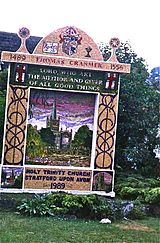 |
The Ebbing and Flowing Well | Tideswell | This spring used to "swell and boil up" like a small river. It was like the ocean tides, but in a tiny channel. However, this special "tidal" action stopped after 1790. Now, the well is mostly forgotten and hidden in a private garden. |
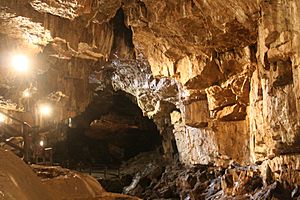 |
Poole's Cavern | Buxton | This is a natural cave made of limestone. It is two million years old! Underground water slowly dissolved the rock to create it. Inside, you can see amazing stalactites (hanging from the ceiling) and stalagmites (growing from the floor). People from the Stone Age, Bronze Age, and Roman times used this cave. It's named after a medieval outlaw named Poole, who used it as a hiding spot. A part of the River Wye flows through the cave. You can take tours along its 300-meter (984-foot) main path. The temperature inside is always a cool 7°C (45°F). |
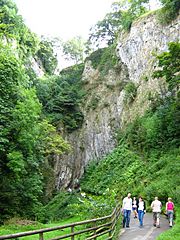 |
The Devil's Arse (Peak Cavern) | Castleton | This natural limestone cave is one of four caves open to visitors in Castleton. It sits in a deep valley below Peveril Castle. The entrance area used to be a settlement where people made ropes for local lead mines for over 400 years. The underground stream inside is called "The Styx," named after a mythical river in ancient stories. This cavern has even been used as a concert hall for music artists! |
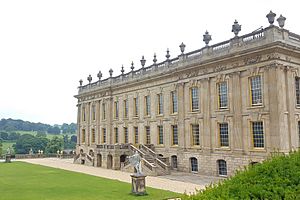 |
Chatsworth House | Chatsworth near Bakewell | This grand country house is the home of the Duke of Devonshire. The Cavendish family has lived here since 1549. The house was built by Bess of Hardwick in the 1550s. It has huge gardens, parkland, and woods that cover almost 2,000 acres. Famous landscape designers like Lancelot "Capability" Brown and Joseph Paxton helped create its beautiful look. The house and park are open to the public and attract many visitors each year. Inside, you can see large collections of paintings, furniture, and sculptures. |
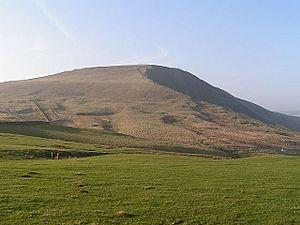 |
Mam Tor | Castleton | This hill is over 500 meters (1,640 feet) high. From the top, you get clear views of the Hope Valley and Kinder Scout. Its name means "Mother Hill." The National Trust looks after this hill. The southeast side of the hill often has landslides. Because of this, a road that crossed it was closed forever in 1979. The strong winds created by the steep hill make it a popular place for paragliders. Old hillforts and burial mounds from the Bronze Age are also protected here. |
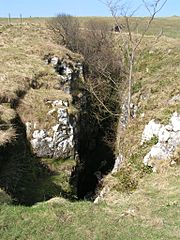 |
Eldon Hole | Eldon Hill near Castleton | This is a deep hole in the ground, like a giant pit. It is 245 feet (75 meters) deep, making it the deepest "pothole" in Derbyshire. The opening at the top is 115 feet (35 meters) long and 20 feet (6 meters) wide. At the very bottom, there is a cave with a dome-shaped roof and stalactites. Old stories say that the devil used to live inside it! |
Mary, Queen of Scots, and the Wonders
Mary Queen of Scots visited three of these wonders a long time ago. Queen Elizabeth I held her prisoner at Chatsworth House many times between 1569 and 1584. Mary's rooms there are still called the "Queen of Scots Apartments."
Queen Elizabeth I allowed Mary to visit St Ann's Well in Buxton to help with her rheumatism (joint pain). Mary visited the well, always with guards, for up to a month at a time, almost every year from 1573 to 1584. In 1582, Mary is also thought to have visited Poole's Cavern in Buxton. Before she left in 1584, she wrote a message in Latin on the window of her room at the Buxton Old Hall. It said:
"Buxton, whose fame thy milk-waters tell, Whom I, perhaps, no more shall see, farewell."
Other Writers and the Wonders
Even before Thomas Hobbes wrote his poem, an expert on old things named William Camden wrote about three wonders and three beauties of the High Peak. This was in his book Britannia, first published in 1586. He described:
"There are in High Peake wonders three,
A deepe hole, Cave, and Den,
Commodities as many bee,
Led, Grasse, and Sheepe in pen.
And Beauties three there are withall,
A Castle, Bath, Chatsworth.
With places more yet meet you shall
That are of meaner worth."
Hobbes' list of attractions became a popular travel plan for rich people. By the 1700s, middle-class people also started visiting them. The poet Charles Cotton helped make these wonders even more famous. In 1681, he wrote his own long poem called The Wonders of the Peake.
Later, in the 1720s, a writer named Daniel Defoe wrote a book called Tour thro’ the Whole Island of Great Britain. In it, he said that only Eldon Hole and Chatsworth were truly "wonders."
See More at the Museum
The Buxton Museum has a special display called 'Wonders of the Peak'. It includes an original copy of Thomas Hobbes's book De Mirabilibus Pecci.
Images for kids


